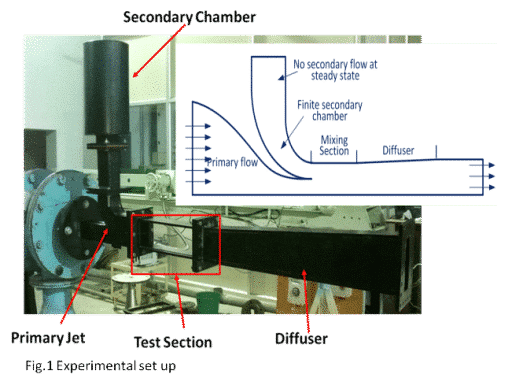Ejectors are devices that are used to transport fluids or mix one stream of fluid with another by pure shearing action of the two streams. Unlike the conventional ejector system, where a constant supply of secondary fluid is maintained, a vacuum ejector system draws secondary stream from a closed chamber there by creating a vacuum condition at secondary chamber. These systems are primarily used to create controlled vacuum exit conditions in high altitude testing (HAT) of rocket engines. It has been observed that the initial process of induction of air from the vacuum or secondary chamber using the primary jet is extremely transient owing to the formation of a highly dynamic separation bubble in the mixing section, which later settles down to a dynamic equilibrium state[1].During this transient regime of the ejector flows, repeated flow reversals are also observed [2] and corresponding oscillations in the flow properties are attributed to the extension and retraction of the separation bubble produced by the primary jet shock wave, into the secondary chamber. Similar oscillations in flow properties in the back pressure chamber as described above, have also been reported in the rocket engine testing in HAT systems [3].
The present work aims at an experimental investigation of the transient flow field in the vacuum ejector-diffusers system with a focus on many interesting and unexplored phenomena such as, transition of shock wave reflection from regular to Mach, unsteady shock-shear layer interactions during the shock transformations and the unsteady compressible shear layer structures.The experimental set-up consists of a primary sonic nozzle, a secondary chamber, mixing chamber (test section) and a diffuser as shown in Fig.1. The primary sonic jet expands into the test/mixing section and causes the entrainment of air from secondary chamber producing a shear layer. The density gradients in the transient flow field are captured using high speed-schlieren imaging. Large scale coherent structures are visible in the developing compressible shear layer, as shown in Fig.2 (a). Weak compression waves are seen to be emanating from the coherent structures within the shear layer. These coherent structures behave similar to blunt bodies in supersonic flow and hence responsible for the generation of the weak compression waves. In Fig.2 (b), the primary jet is seen to be further expanded due to the transient reduction in the mixing chamber pressure caused by the entrainment action. The primary jet, which is confined between the shear layer and the wall, experiences a situation similar to an over expanded flow through nozzle divergence and an oblique shock wave is formed to match the downstream pressure condition. When the jet expands below a critical pressure level, a regular reflection (RR) of the oblique shock wave will not be able to provide the sufficient pressure rise required for the pressure equilibrium. At this stage, the RR of the oblique shock wave transforms into a Mach reflection (MR) with a typical lambda shock structure as can be clearly seen from Fig.2(c). As a consequence of increase in shock strength, the mixing section pressure increases and jet expansion reduces which is followed by downstream running of shock wave which reduces the shock strength. This again produces an RR and re-initiates the favorable condition for jet expansion. The regular reflection and related downward displacement of the shear layer indicating the reduced expansion levels can be seen in Fig.2 (d). These jet expansion and re-compressions produce an oscillatory shear layer and corresponding RR-MR transformations and will continue until a dynamic pressure equilibrium [2] is reached. The sequential flow field images in Fig.3 are a qualitative depiction of the transformation of RR to MR which reveals the shock and shear layer oscillations in the mixing section. These pictures also manifest that the interaction of the shock wave with the shear layer enhances the growth of the coherent structures and hence the spatial development of the shear layer.



Detailed pressure data in the mixing chamber and the secondary chamber is needed to correlate the shock and shear layer oscillation and the pressure equilibrium conditions. This along with the velocity measurements will bring out a clearer understanding of the RR-MR transformation and its interaction with the unsteady compressible shear layer. Studies on shock interaction with the shear layer and its effect on turbulence and vorticity distribution within the shear layer are in progress.
[1] V. Lijo, H. D. Kim, G. Rajesh, T. Setoguchi. “Numerical simulation of transient flows in a vacuum ejector-diffuser system", Proceedings of the Institution of Mechanical Engineers, Part G: Journal of Aerospace Engineering, Vol. 224, No. 7 (2010), pp. 777-786
[2] A. Mittal, G. Rajesh, V. Lijo, and H. D. Kim. "Starting Transients in Vacuum Ejector-Diffuser System", Journal of Propulsion and Power, Vol. 30, No. 5 (2014), pp. 1213-1223
[3] W. V Antro, M. Jegesh David, J. Suderson, K. Alaguvelu. 2013, “Experimental Trials of Cluster nozzle Supersonic Ejector for High Altitude Testing of Cryogenic Engine” ,International Conference on Computer Aided Engineering (CAE-2013), IIT Madras, Chennai.

